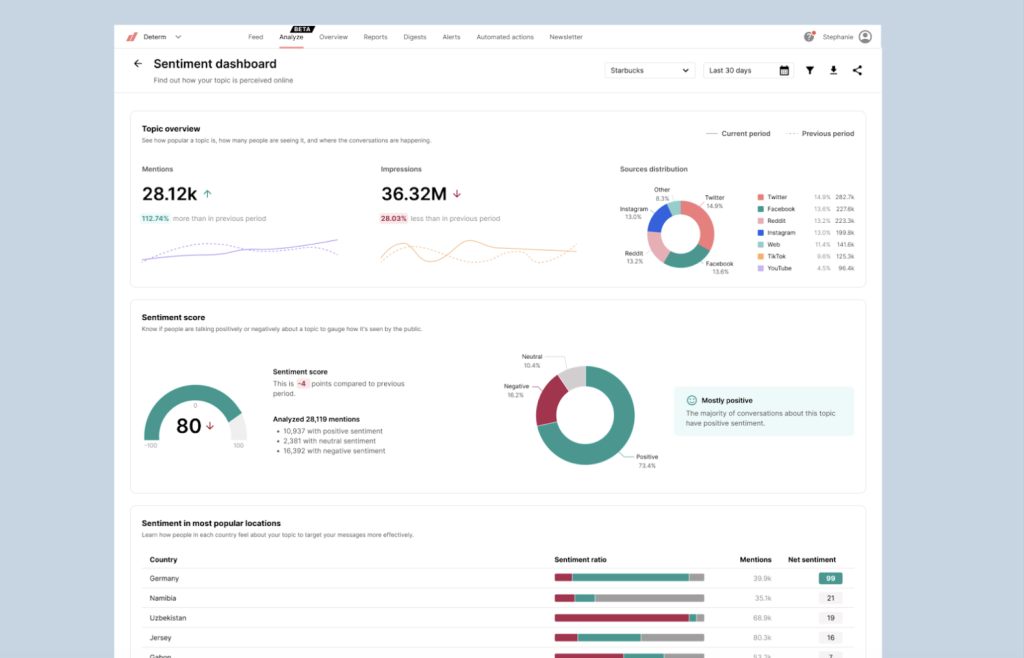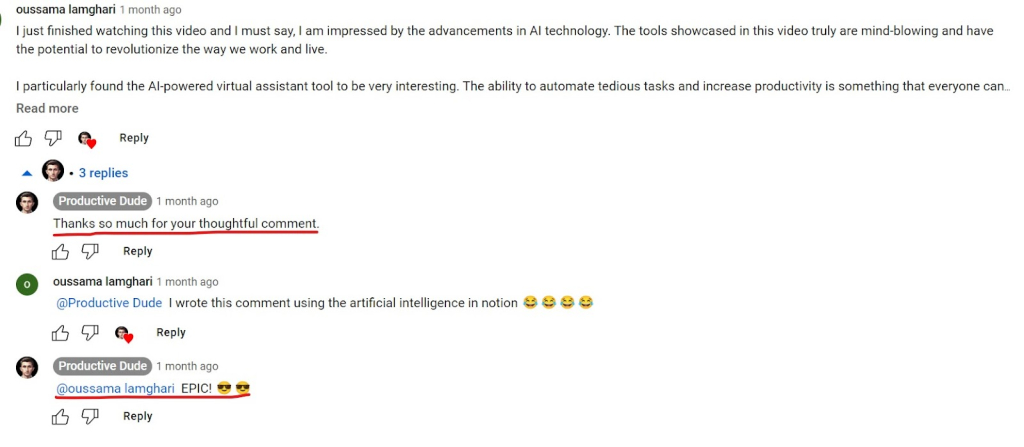Have you ever faced a situation where customers seem to be losing interest in your brand, leaving you wondering what went wrong?
You’ve worked hard to build a strong brand identity, but somehow, it just doesn’t seem to resonate with your target audience. The key to turning this situation around lies in understanding, improving, and being able to measure customer sentiment data for your brand.
💡 Read Sentiment Analysis 101: Everything You Need to Know
When customers feel connected and valued, they become loyal brand advocates, spreading positive word-of-mouth and influencing others to join them.
So, how do you foster these positive feelings and perceptions? Here are the steps to take to achieve just that.
What is Customer Sentiment?
Customer sentiment refers to the collective feelings, perceptions, and attitudes that customers have towards a brand, its products, or its services.
It is a crucial aspect of understanding how customers perceive and interact with a brand, which in turn influences their purchasing decisions, loyalty, and word-of-mouth recommendations.
So, why would you measure customer sentiment and how can it help your brand?
By gauging customer sentiment, businesses can identify areas that need improvement, adjust their strategies, and create more meaningful connections with their customers to foster positive experiences and long-term relationships.

How Can You Improve Customer Sentiment For Your Brand?
Here are the 6 ways to improve customer sentiment for your brand to ensure customer satisfaction.
1. Understand and monitor customer sentiment
To effectively improve customer sentiment for your brand, you must first understand what your customers are saying about you. This involves tracking their opinions across various channels and following the customer journey from start to finish.
This is the first level of engaging in customer sentiment analysis that you must tend to in order to effectively improve customer sentiment for your brand
Importance of media monitoring and social listening
- Media monitoring and social listening involve tracking brand mentions, conversations, and engagement across different platforms.
- Use a comprehensive media monitoring tool like Determ to gain valuable insights into the public’s perception of your brand.
- Identify areas that need improvement based on the data you gathered.

Analyzing customer feedback and reviews
- Regularly review customer data via comments on social media, customer support tickets, and online review platforms.
- Look for patterns and trends that indicate areas of strength and weakness.
- Asses where the bulk of your negative reviews are focused on.
If you can understand and track customer sentiment across your brand this will help shape your brand’s image and reputation.
By leveraging media monitoring tools like Determ and analyzing customer feedback, you can uncover valuable insights into the public’s perception of your brand in just 3 clicks!
Utilizing the right tools is critical in order to leverage technology to improve your brand reputation.
2. Develop an effective PR strategy
A well-planned PR strategy is essential for shaping and maintaining a positive customer sentiment for your brand. The right PR approach can not only help you share your brand story but also build credibility, trust, and customer loyalty.
Aligning PR efforts with brand values
- Ensure your PR efforts are aligned with your brand values for consistent messaging and authenticity.
- Highlight your brand’s unique selling points in your PR campaigns.
- Create a sense of trust and reliability that customers can connect with.
Read Optimizing Your PR Budget: 5 Ways Media Monitoring Tools Can Help
Building relationships with key influencers and media outlets
- Develop strong relationships with key influencers in your industry and relevant media outlets.
- Reach out to them with compelling stories, unique angles, and valuable insights that resonate with their audience.
- Leverage these relationships to amplify your brand’s message and foster positive customer sentiment.
For instance, if you’re a tech company, partner with a well-known tech influencer to review your latest product, or invite a respected journalist to cover your groundbreaking research.
By leveraging these relationships, you can amplify your brand’s message and foster positive customer sentiment.
3. Prioritize customer service and support
Delivering exceptional customer service and support is crucial for maintaining positive customer sentiment scores across your brand. By focusing on your customers’ needs and addressing their concerns, you can foster long-lasting relationships and brand loyalty.
Whether you have a customer service team, or manually gather customer feedback, it’s a vital aspect of any brand to bolster brand reputation.

Implementing a customer-centric approach
- Put your customers at the heart of your business strategy and decision-making processes.
- Train your customer support team to empathize with customers and understand their needs.
- Offer multiple channels for customer support, such as email, phone, live chat, and social media.
Proactively addressing issues and concerns
- Monitor customer feedback and reviews to identify common issues and concerns.
- Develop a plan to address these issues and prevent them from recurring.
- Communicate your actions and solutions to your customers, showing that you value their feedback and are committed to improving their experience.
One interesting tip around customer services is to leverage competitors’ negative reviews. By monitoring and following competitors’ customer reviews you can prioritize quality customer service where your competitors lack.
For example, if your competitor has negative sentiment around slow response time due to customer queries that can be something that your brand focuses on to ensure competitive advantage.
4. Engage with customers on social media
Social media has become an essential platform for connecting with customers and managing their sentiments toward your brand. By actively engaging with your audience, you can create a strong brand presence and foster positive customer sentiment.
Creating a strong social media presence
- Develop a consistent and authentic brand voice for your social media profiles.
- Share engaging and valuable content that resonates with your target audience.
- Use visual elements, such as images and videos, to capture your audience’s attention and increase engagement.
Responding to customer inquiries and feedback
- Monitor your social media profiles for customer comments, questions, and reviews.
- Respond to inquiries and feedback in a timely and genuine manner.
- Use customer feedback as an opportunity to improve your products and services, and show your commitment to customer satisfaction.

As you can see, even simple comments like these can have major impacts on positive sentiment from your customers.
Imagine you get a notification from your favorite brand or company saying they appreciate you. Likely something you won’t forget!
5. Utilize competitor analysis to stay ahead
In today’s competitive landscape, understanding your competitors’ strategies and staying ahead is crucial to maintaining a positive customer sentiment. By analyzing your competitors, you can identify opportunities for growth and adapt to changing customer expectations.
Learning from successful competitors’ strategies
- Conduct regular competitor analysis to identify their strengths and weaknesses.
- Analyze their marketing campaigns, customer service approaches, and product offerings.
- Use these insights to refine your own strategies and identify areas for improvement or innovation.
Adapting to evolving customer expectations
- Keep track of industry trends and changes in customer preferences.
- Regularly evaluate your product and service offerings to ensure they meet current customer demands.
- Update your brand messaging and communication strategies to resonate with your target audience.
Utilizing your competitor’s pitfalls as well as success is a great way to stay ahead of the curve and garner different customer perceptions of the industry your brand is positioned in.
Read A Step-By-Step Tutorial for Writing a Competitor Analysis Report for Your Company
6. Encourage positive customer behavior
Creating a positive customer sentiment involves not only addressing customer concerns but also encouraging positive behavior. By implementing reward programs and promoting user-generated content, you can motivate customers to actively engage with and advocate for your brand.
Reward programs and loyalty schemes
- Develop loyalty programs that reward customers for their repeat business and referrals.
- Offer exclusive deals, discounts, or perks to your most loyal customers.
- Regularly review and update your reward programs to keep them fresh and enticing.
Encouraging user-generated content and testimonials
- Create opportunities for customers to share their experiences with your brand, such as social media contests or hashtag campaigns.
- Encourage customers to leave reviews on your website, social media profiles, or third-party review platforms.
- Showcase positive user-generated content and testimonials on your marketing materials to build trust and credibility with prospective customers.
Final Take Aways
With seemingly millions of tasks and areas of improvement to focus on within a company, customer sentiment analysis can often be neglected.
While the strategies laid on in the article are proven to show results in improving and tracking customer sentiment for your brand, they are only as effective as the effort you put into monitoring them.
Doing this will ensure you foster strong connections with your customers, enhance your brand reputation, and will ultimately pave the way for long-term success.
Remember, the key to a thriving brand lies in continuous improvement and innovation in brand reputation management. So, stay proactive, listen to your customers, and adapt to their ever-evolving needs and expectations.
Luke is a published author, technology strategist, and creator of multiple online businesses working in the SAAS space. He writes about the intersection of AI, software, and tech in relation to business, writing, and creating at LukeLovelady.com. Luke is currently working for a B2B SaaS company as a Sales Development Representative.


